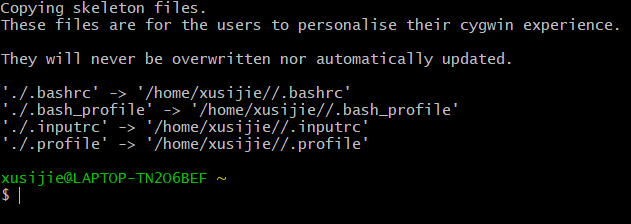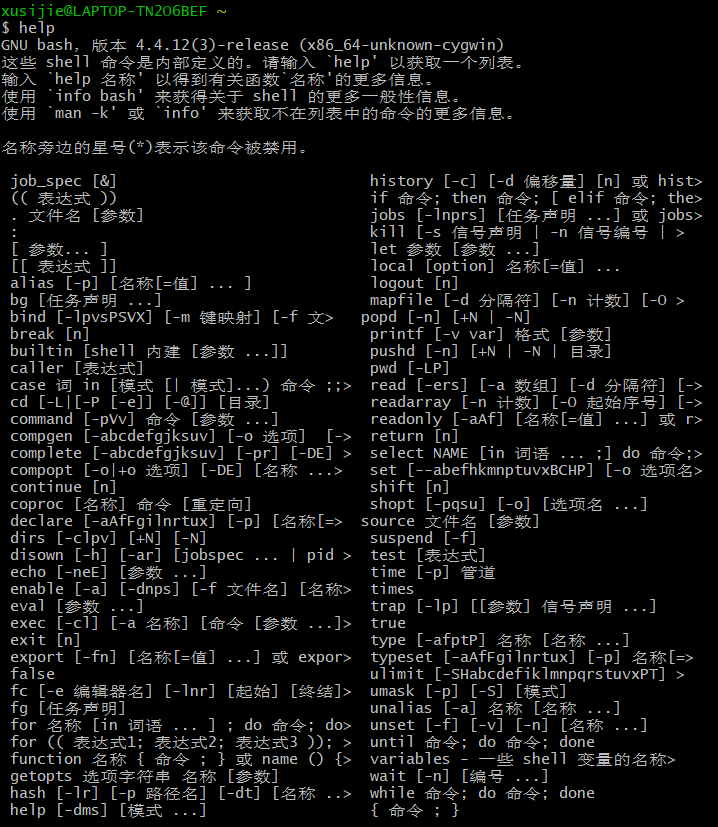OS第1次实验报告:熟悉使用Linux命令和剖析ps命令
- 姓名:徐思婕
- 学号:201821121004
- 班级:计算1811
1. 实验环境介绍
给出实验环境:
- 操作系统:Microsoft Windows [版本 10.0.18363.657]
- 平台:Cygwin
用户名设为自己名字的拼音:

2. 常用命令使用
- man
![]()
- help

- ls -a
![]()
- ls -al

3. 剖析ps命令
- 运行
man ps,将ps使用方法拷贝过来:
SYNOPSIS
ps [−aA] [−defl] [−g grouplist] [−G grouplist]
[−n namelist] [−o format]... [−p proclist] [−t termlist]
[−u userlist] [−U userlist]
ps [−aA] [−defl] [−g grouplist] [−G grouplist]
[−n namelist] [−o format]... [−p proclist] [−t termlist]
[−u userlist] [−U userlist]
DESCRIPTION
The ps utility shall write information about processes, subject to
having appropriate privileges to obtain information about those pro‐
cesses.
The ps utility shall write information about processes, subject to
having appropriate privileges to obtain information about those pro‐
cesses.
By default, ps shall select all processes with the same effective user
ID as the current user and the same controlling terminal as the in‐
voker.
ID as the current user and the same controlling terminal as the in‐
voker.
OPTIONS
The ps utility shall conform to the Base Definitions volume of
POSIX.1‐2008, Section 12.2, Utility Syntax Guidelines.
The ps utility shall conform to the Base Definitions volume of
POSIX.1‐2008, Section 12.2, Utility Syntax Guidelines.
The following options shall be supported:
−a Write information for all processes associated with termi‐
nals. Implementations may omit session leaders from this
list.
nals. Implementations may omit session leaders from this
list.
−A Write information for all processes.
−d Write information for all processes, except session leaders.
−e Write information for all processes. (Equivalent to −A.)
−f Generate a full listing. (See the STDOUT section for the
contents of a full listing.)
contents of a full listing.)
−g grouplist
Write information for processes whose session leaders are
given in grouplist. The application shall ensure that the
grouplist is a single argument in the form of a <blank> or
<comma>-separated list.
Write information for processes whose session leaders are
given in grouplist. The application shall ensure that the
grouplist is a single argument in the form of a <blank> or
<comma>-separated list.
−G grouplist
Write information for processes whose real group ID numbers
are given in grouplist. The application shall ensure that
the grouplist is a single argument in the form of a <blank>
or <comma>-separated list.
Write information for processes whose real group ID numbers
are given in grouplist. The application shall ensure that
the grouplist is a single argument in the form of a <blank>
or <comma>-separated list.
−l Generate a long listing. (See STDOUT for the contents of a
long listing.)
long listing.)
−n namelist
Specify the name of an alternative system namelist file in
place of the default. The name of the default file and the
format of a namelist file are unspecified.
Specify the name of an alternative system namelist file in
place of the default. The name of the default file and the
format of a namelist file are unspecified.
−o format Write information according to the format specification given
in format. This is fully described in the STDOUT section.
Multiple −o options can be specified; the format specifica‐
tion shall be interpreted as the <space>-separated concate‐
nation of all the format option-arguments.
in format. This is fully described in the STDOUT section.
Multiple −o options can be specified; the format specifica‐
tion shall be interpreted as the <space>-separated concate‐
nation of all the format option-arguments.
−p proclist
Write information for processes whose process ID numbers are
given in proclist. The application shall ensure that the
proclist is a single argument in the form of a <blank> or
<comma>-separated list.
Write information for processes whose process ID numbers are
given in proclist. The application shall ensure that the
proclist is a single argument in the form of a <blank> or
<comma>-separated list.
−t termlist
Write information for processes associated with terminals
given in termlist. The application shall ensure that the
termlist is a single argument in the form of a <blank> or
<comma>-separated list. Terminal identifiers shall be given
in an implementation-defined format. On XSI-conformant sys‐
tems, they shall be given in one of two forms: the device's
filename (for example, tty04) or, if the device's filename
starts with tty, just the identifier following the characters
tty (for example, "04").
Write information for processes associated with terminals
given in termlist. The application shall ensure that the
termlist is a single argument in the form of a <blank> or
<comma>-separated list. Terminal identifiers shall be given
in an implementation-defined format. On XSI-conformant sys‐
tems, they shall be given in one of two forms: the device's
filename (for example, tty04) or, if the device's filename
starts with tty, just the identifier following the characters
tty (for example, "04").
−u userlist
Write information for processes whose user ID numbers or lo‐
gin names are given in userlist. The application shall en‐
sure that the userlist is a single argument in the form of a
<blank> or <comma>-separated list. In the listing, the nu‐
merical user ID shall be written unless the −f option is
used, in which case the login name shall be written.
Write information for processes whose user ID numbers or lo‐
gin names are given in userlist. The application shall en‐
sure that the userlist is a single argument in the form of a
<blank> or <comma>-separated list. In the listing, the nu‐
merical user ID shall be written unless the −f option is
used, in which case the login name shall be written.
−U userlist
Write information for processes whose real user ID numbers or
login names are given in userlist. The application shall
ensure that the userlist is a single argument in the form of
a <blank> or <comma>-separated list.
Write information for processes whose real user ID numbers or
login names are given in userlist. The application shall
ensure that the userlist is a single argument in the form of
a <blank> or <comma>-separated list.
ps命令有很多参数,运行命令ps -ef,给出你系统的返回结果:

- 解释ps -ef命令中参数的含义:
-e:将所有信息写入进程;
-f:生成完整的列表。
- 解释返回结果每个字段的含义:
UID:用户ID
PID:进程ID
PPID:父进程ID
C:CPU占用资源百分比
STIME:系统启动时间
TTY:终端的次要装置号码
COMMAND:执行的命令- 给出ps aux执行结果,解释命令中的参数:

- 解释ps aux命令中参数的含义:
a:为终端相关的所有进程写入信息
u:以用户为主的格式来显示程序状况
x:显示所有程序,不以终端机来区分
- 对执行结果,每个字段进行解释:
PGID:进程组ID
COMMAND:所执行的指令
4. 通过该实验产生新的疑问及解答
- 如何修改cygwin的用户名:
在cygwin中输入命令mkpasswd -l > /etc/passwd 生成password文件。在ect目录中找到这个文件并打开,将最后一行中的三处默认用户名更改为xusijie。接着在cygwin的 home目录下面建立目录xusijie,启动cygwin进入以后,用户名就更改完成了。 



 浙公网安备 33010602011771号
浙公网安备 33010602011771号